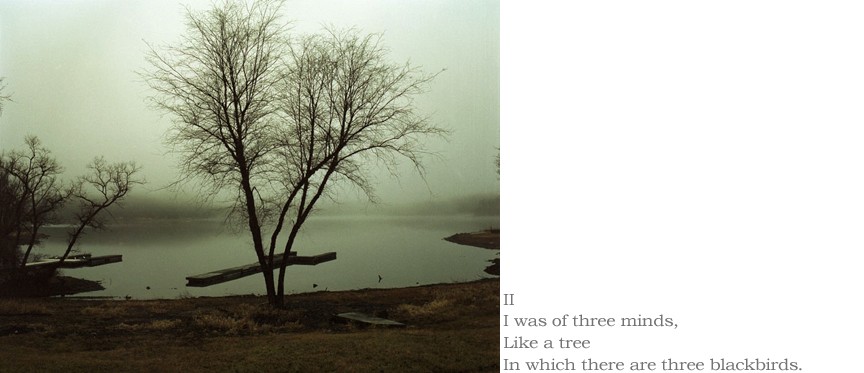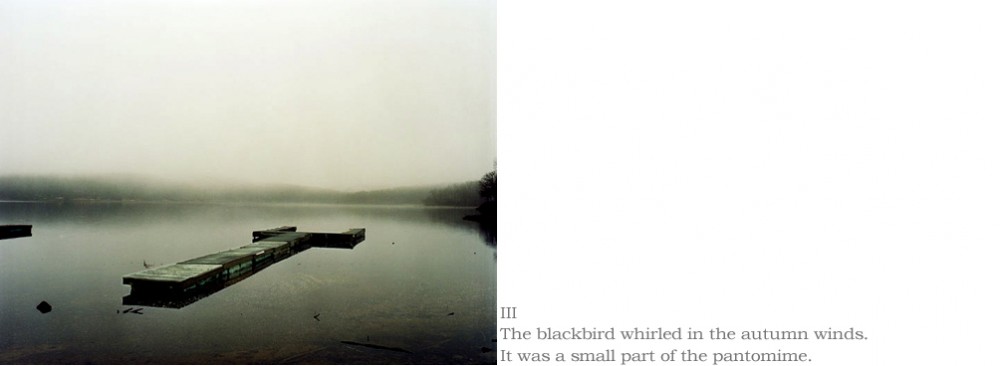- 13 Ways of Looking: a series by Lorena Endara
by Emiliano Valdés
I
- A place, the way light shines upon it, the passage of time, the sights that change
throughout the day, the textures of the objects and the shadows that invariably
lie between the subject and the camera. Arbitrariness. These situations, the
matter of life as perceived not by our eyes but by our minds, tend to escape
the grandiloquence of image production today, usually steered by fashion,
manipulation and effective formulas. Those images deceive the trained gaze
stage-managing impressive subjects, bold colours, trendy subjects. But not ’13
ways of looking’. This series of photographs relies on the imperceptible to speak:
they depict barely anything at all and yet they tell everything. The secret lies
on the fact that reality, apparently, is made of facts and things just as much as
it is made of imagination. Perhaps it is because this series contains that exact
combination of the two elements that it manages to capture all that is around us
so well.
‘13 ways of looking’, a project that both feeds from and complements the poem
by Wallace Stevens by which it is in fact accompanied, is a series of photographs
by Panamanian landscape photographer Lorena Endara that portrays nothing
more, but also nothing less, than a place and the passage of time. It tells the
story of a location; it captures its essence, and by doing so reminds us of our
own story and of its brief duration. It is in the absence of narrative and through
a sort of meditative action that the author manages to convey a sense of the
transcendental. But the anti-narrativeness is only apparent: by putting together
a sequence of similar images of the same subject over a certain amount of time,
a story is told. Not through actions and events, but through the gaps between
them.
The thirteen images and the equal amount of verses from the poem work in a
symbiotic relationship. Words complement the construction of each discourse
and ultimately yield into a single one. Details, absent from the picture, are filled
in by the words, not illustrating or explicating them but rather working as two
different states of the same signifier. It is as if the words would tell not what is
shown in the photographs but what the photographs actually mean. Indeed,
the pictures are not simple illustrations of the verses nor the verses tell what
happens in the images, they provide different visions of a shared reality (and
imagination).
II
Since the beginning of representation, but particularly during the late 18th
century and onwards, landscape has been treated as the complying backdrop
for the psychological nature of the subject in almost every image. The context
was impregnated by whatever was being depicted, whether on a painting, a
photograph or even in literature, and it would reinforce the script of the action
or the personality of the characters. This treatment of the landscape has been
widely employed, even to our days, to intensify the motif of the scene, its
narrative, and its morality. The landscape would formalise (in the literal sense of
the word) the qualities of the subject or the action and surrender to a secondary
plane: mere set or counterpart.
But what happens when the landscape is both subject and context? What is
there to complement or to turn into when there is no action beyond that of reality
itself? The landscape cannot but acquire the form of its own temperament,
assume and re-present its own essence, its very nature, the image of nothing
but itself. In ‘13 ways of looking’ the melancholy and transcendental feel of the
pictures convey only the landscape’s own state of mind. And perhaps that of the
artist’s. The former is not manoeuvred to enhance a personality or the drama
being depicted. It presents its own drama: the construction of a reality, the
passage of time, the burden of being.
It is through the objectification of the landscape that it displays its full potential
as a subject and its connotations become explicit. Perhaps because ultimately
the landscape works as an indexing element of land itself and thus of the
context of human life that it is always read as more than it (re)presents. Through
its metaphorical nature, it can come to state precisely that which cannot be
described. Despite the fact that landscape has been, for the last 50 years,
approached from a culturalist point of view (that is, exploring the human
presence and its impact on the land), its nature and form continues to be used
as an analogy of human existence and investigative arena for philosophical
concerns.
But because landscape is in fact a cultural construction, it is through its
reading (and clearly also through its depiction) that it suggest a particular way
of understanding and responding to it and hence, a sense of belonging to a
particular moment in time and a place in the world. It is our understanding of
it that determines the way we relate to the world and ultimately, to life. This
is one of the reasons for which landscape photography has never ceased to
be a fundamental subject in the history of creation and in the work of our photographer.
III
In an approach to photography that recalls that of Stevens to poetry, Endara puts
together several images of the changing reality of one place to build an evocative
and perhaps paradoxically realistic portrait of it. The image of that particular
corner of the world with a dock, a tree, a body of water, some snowy mountains,
perhaps a black bird, is built not through one but through several visions of it;
it is their summing up that gives us a sharp sense of its spirit. It is also in this
contradiction (the fact that a precise images is actually formed by many visions)
that the merging of reality and imagination takes place. This, in both versions
of ’13 ways of looking’, reality is the product not only of the creative process (i.e.
the imagination) of the authors but also of the recurrence and almost mantric
repetitive process of construction. Not accumulative but juxtaposing moments,
visions and thoughts, the poet and the photographer manage to put together a
place that is so subjective that becomes mordantly real. The series of pictures,
shot over a period of time, has the ability to speak not only of the place, but also
of its own process of change.
This working method is not coincidental or random, it responds to a thorough
interest in Steven’s “poetry of ideas”. The vision that reality is not static but rather
something created through passionate engagement with what is around us has
produced a work that rests on contemplation to produce an accurate depiction of
our world. But it is not the actual shapes or words, but rather their filtered images
that when finally do reach our mind, constitute the strength in both of these
works. By giving us different versions of an idea, Endara and Stevens emphasize
the unity of their subject and in doing so they highlight the importance of all
things arbitrary. And of the importance of imagination in the definition of reality.















